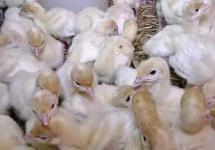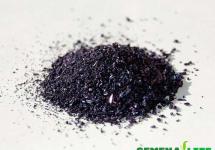Asparagus is perennial vegetable plantwhich, thanks to its excellent taste and unpretentiousness in care, uses well-deserved love for dachens and gardeners. We will tell in more detail how it grows and what care will be required by this vegetable culture.
Description of culture
 Today it is known about one hundred different types of sparkywhich, depending on their species, can differ significantly to the appearance and taste characteristics of the crop grown. Asparagus received the greatest distribution, which is successfully grown by gardeners and has a magnificent subtle taste.
Today it is known about one hundred different types of sparkywhich, depending on their species, can differ significantly to the appearance and taste characteristics of the crop grown. Asparagus received the greatest distribution, which is successfully grown by gardeners and has a magnificent subtle taste.
This is a perennial grassy plant can grow and fruit for 20 years, forming fifty and more edible shoots from one root. The height of the plant in vivo reaches one and a half meters, and plants are distinguished by magnificent frost resistance. The bush of the plant has highly branched green stems, on which thin twigs are located and small wounds with inedible red berries. Asparagus, only young stems are ediblewhich contain beta-carotene, calcium and iron, ascorbic acid, copper, phosphorus, sodium and other trace elements that are necessary to human body for proper livelihoods.
Growing asparagus on the nursery
 To date, two ways to grow asparagus received the greatest distribution: by landing seeds in open soil and pre-cultivation of seedlings. Beginner gardeners can recommend growing asparagus, planting seeds into an open ground. This will significantly simplify the care of this vegetable culture, while using high-quality planting material, you can get an excellent harvest. But the pre-cultivation of seedlings is more difficult, but at the same time the gardener gets the opportunity to grow strong and life-in-law plants, which with ease tolerate the winter and continue perfectly fruit.
To date, two ways to grow asparagus received the greatest distribution: by landing seeds in open soil and pre-cultivation of seedlings. Beginner gardeners can recommend growing asparagus, planting seeds into an open ground. This will significantly simplify the care of this vegetable culture, while using high-quality planting material, you can get an excellent harvest. But the pre-cultivation of seedlings is more difficult, but at the same time the gardener gets the opportunity to grow strong and life-in-law plants, which with ease tolerate the winter and continue perfectly fruit.
Engage in the cultivation of asparagus, it should be remembered that the first harvest can only be obtained for the 3rd year after it landing.. Caring for this plant culture does not represent difficulties, which makes it extremely popular at the gardeners. Let's talk in more detail about how to grow asparagus in the garden.
Landing
 Asparagus, the cultivation of seeds of which does not represent difficulties, can be planted at the end of May and in September. It is necessary to pre-prepare the soil pre-prepare, for which the land is drunk, purified from weeds and an organic fertilizer is made from the calculation to the square meter of a 50 kilogram of humus.
Asparagus, the cultivation of seeds of which does not represent difficulties, can be planted at the end of May and in September. It is necessary to pre-prepare the soil pre-prepare, for which the land is drunk, purified from weeds and an organic fertilizer is made from the calculation to the square meter of a 50 kilogram of humus.
Seeds are planted with rows with a transcendent distance of at least 25 centimeters. Immediately after landing, the Ginochka must be rich enough and hide the film, which is removed as soon as the first shoots appear.
Aspassing and growing asparagus slowly, so the first shoots will appear no earlier than 20 days after landing. Several acceleration can be accelerated by pre-training seeds that are soaked for a week in warm water. Water when soaking must be changed every day.
Correct landing care
Asparagus is growing extremely slow. Usually by the end of the first year of life, the height of the ground part reaches 15-20 centimeters. Only individual hybrid varieties are characterized by a rapid growth rate and allow you to receive the first harvest for the second year after planting seedlings.
Landing care does not represent any complexity. The beds must be regularly water and pour. In June, feeding is performed using nitrogen fertilizers. We can recommend you to use the following mineral fertilizers:
- Urea.
- Ammonium nitrate.
- Wood ash.
 Also, excellent results showing the apparer of the scripts with a zhyge, which is diluted in water with proportions 1 to 6. When ensuring appropriate care by the end of August, asparagus will have three or four escapes and a small well-developed rhizome. Gardener will need to properly prepare plants by winter. At the end of August or early September, the fertilization of landing of potassium and phosphorus is held. In October, the plants die the ground part, after which the soil is mured with peat or humus with a layer of no more than 3 centimeters. Additionally, it is possible to cover the bed with fallen foliage or pagan.
Also, excellent results showing the apparer of the scripts with a zhyge, which is diluted in water with proportions 1 to 6. When ensuring appropriate care by the end of August, asparagus will have three or four escapes and a small well-developed rhizome. Gardener will need to properly prepare plants by winter. At the end of August or early September, the fertilization of landing of potassium and phosphorus is held. In October, the plants die the ground part, after which the soil is mured with peat or humus with a layer of no more than 3 centimeters. Additionally, it is possible to cover the bed with fallen foliage or pagan.
Aspass care for the second year of cultivation
 In the spring will need additional fallen landing with mineral fertilizersWhat will allow you to quickly accelerate the growth of asparagus, which will quickly gain a green mass, and the roots in the ground will grow up, and in the subsequent will be easily transferred to the winter. The soil along the rows of plants should be disappeared, such a work is performed as neat as possible, eliminating the damage to the roots.
In the spring will need additional fallen landing with mineral fertilizersWhat will allow you to quickly accelerate the growth of asparagus, which will quickly gain a green mass, and the roots in the ground will grow up, and in the subsequent will be easily transferred to the winter. The soil along the rows of plants should be disappeared, such a work is performed as neat as possible, eliminating the damage to the roots.
Subsequent landing care implies only regular watering and weeding bed. In the dry soil, Sparagi's shoots acquire a bitter taste and become fibrous. That is why watering landings is carried out at least once a week. It will not be superfluous to feed the landing, for which a solution of mineral fertilizers based on nitrogen cowboat is used. Preparing plants by winter for the second year of cultivation does not represent much difficulty. After moving the ground green part of the plants, the beds are mulched by a humor, peat or other organic.
Cleaning harvest and asparagus care
The first harvest is performed on the third year after landing. By this time, the plants will become bushy and magnify large-sized rhizome. Even before harvesting, the harvest in the early spring, there is a deep breakdown, and the plants are highly dipped with humus and soil. Usually in the third decade of April, young shoots appear under the soil, which in a few months reach ingoing ripeness, after which the harvest can be started. Such shoots that reach lengths of 5-7 centimeters can be cut off every three days for a month..
With three-year-old bushes, 5-7 shoots are usually cut. In subsequent years, from each such plant can be cut off by approximate 15 shoots. After the end of the harvest period, 3-5 shoots should be left on asparagus, from which powerful stems with second and third-order branches are subsequently formed. In the autumn, the green part deviates again and the gardener will remain only to feed the beds and insulate the planting with a small layer of mulch.
 Assembly care in the post-harvest period should be given to maximum attention. It is at this time that the basis of the future harvest is laid. In the aisle, it should be filled with a humid, a small amount of wood ash and to close mineral nitrogen fertilizers into the soil. In the summer, after the end of the harvest period, the script should be poured once a week. After such watering, the soil is necessarily loose, which prevents the formation of surface crust.
Assembly care in the post-harvest period should be given to maximum attention. It is at this time that the basis of the future harvest is laid. In the aisle, it should be filled with a humid, a small amount of wood ash and to close mineral nitrogen fertilizers into the soil. In the summer, after the end of the harvest period, the script should be poured once a week. After such watering, the soil is necessarily loose, which prevents the formation of surface crust.
In the future, departure care is not difficult. The following works will be performed:
- Loose aisle;
- Remove weeds;
- Feed the landings with a lightweight cow and mineral nitrogen-based fertilizers.
Growing a seaside way
The cultivation of seedlings at home is not particularly difficult. It is only necessary to use high-quality fertile soil, which will allow as soon as possible to grow a life-made and severe seedlings, which quickly carries out in a new place and in the subsequent easily tolerates cold winters.
Seed seeds should be in fertile soil who prepare mixture of sand, garden land and peat. Having exhausted and showing pre-seeds, you can get the first shoots after one or two weeks after landing. Subsequently, care for seedlings is regular watering and temperature maintenance at 20-22 degrees. After a half or two months later, the plants are fixed and they can be easily transplanted into open ground.
Growing Asparagus Sort Argent
 Popularity in gardeners uses asparagus argentor varietiesFrom whose features, we note the low-fiber large shoots of white. The cultivation of this type is performed according to standard technology, which allows planting of a vegetable, both seeds directly on the garden and with the help of seedlings, which are struck at home and subsequently transferred to beds. The first harvest of this grade gardener will receive on the third year of cultivation, and in the subsequent plants excellent fruit, allowing you to receive up to 20 shoots from one adult root.
Popularity in gardeners uses asparagus argentor varietiesFrom whose features, we note the low-fiber large shoots of white. The cultivation of this type is performed according to standard technology, which allows planting of a vegetable, both seeds directly on the garden and with the help of seedlings, which are struck at home and subsequently transferred to beds. The first harvest of this grade gardener will receive on the third year of cultivation, and in the subsequent plants excellent fruit, allowing you to receive up to 20 shoots from one adult root.
Examination asparagus in winter
Gardeners can easily cultivate this universal vegetable culture in the summer in the garden and winter in warm heated greenhouses. For such an interviews, the rhizomes of adult five-year plants are used. In October, it is necessary to dig up the roots of asparagus, which until December are retracted to the basement, where the temperature is maintained at around zero degrees.
 In early December, the scrutized asparagus rootes are planted in a greenhouse in a small container in its size. The containers themselves are tightly pressed to each other, which allows one square meter to place at least 20 boxes with asparagus. From above, the rhizomes should be filled with a 20 centimeter layer by humus. Containers are additionally covered with polyethylene black film.
In early December, the scrutized asparagus rootes are planted in a greenhouse in a small container in its size. The containers themselves are tightly pressed to each other, which allows one square meter to place at least 20 boxes with asparagus. From above, the rhizomes should be filled with a 20 centimeter layer by humus. Containers are additionally covered with polyethylene black film.
In the first week in the greenhouse, the temperature should be maintained at a level of 10 degrees, and as soon as the roots move to the growth temperature smoothly increases to 18 degrees. Such a temperature mode is supported 2 months, that is, throughout the entire period of harvesting. Such an original asparagus extinguishing technology in winter can be used both in warm greenhouses and at home with sprinkling root on a glazed balcony.
Pests and asparagus diseases
Of the propagated this fruit culture, we note the sparky leaf. This insect can appear in the middle of summer, completely destroying the foliage. As soon as you noticed small black or yellow bugs and their black larvaeshould be carried out by planting insecticide. We recommend using the following agrochemicals in the garden:
- Fufanon;
- Phytodeter;
- AKTELLIK
Also damaging asparagus can wirefronts, Khrushchi, Slug and Medved. As prophylaxis against these insects, asparagus should be treated with insecticides and regularly pouring the beds, which will be excellent prevention against the appearance of various insects and diseases of this culture.
From common diseases, we note red rot rootswhich is caused by fungi. The roots and root cervies are affected by the fallen plants in the garden. Once you have noticed small propellars on the stem and in the area of \u200b\u200bthe root neck, you should handle asparagus with agrochemicals of Fundazole. With serious infection, the plants should be destroyed, and the bed with a new plantation lay in a new place.




Conclusion
Asparagus is a long-term vegetable culture that allows you to get a great harvest. Horticulturian asparagus enjoys very popular with gardeners, how to grow we told you in this article. A feature of the cultivation of asparagus is only the fact that the first harvest can be obtained only for the third year after sowing seeds. However, care for this vegetable culture does not represent a special difficulty, so we can recommend asparagus to everyone without exception to gardeners.


